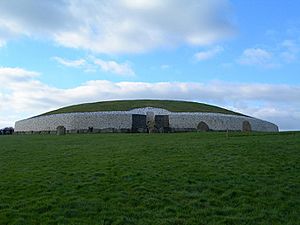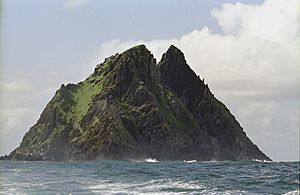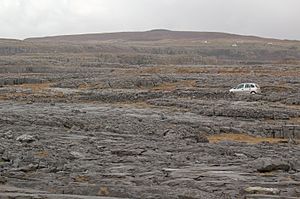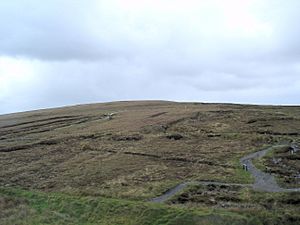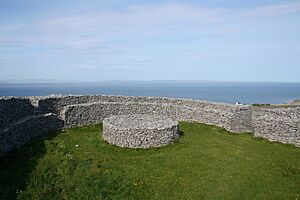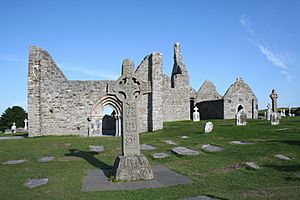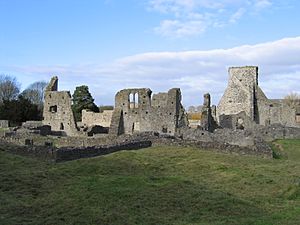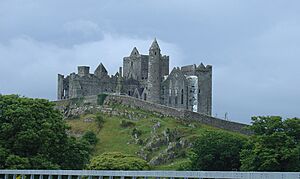List of World Heritage Sites in the Republic of Ireland facts for kids
Imagine a special club that protects the most amazing places on Earth! That's kind of what the United Nations Educational, Scientific and Cultural Organization (UNESCO) does. They look after World Heritage Sites. These places are super important because of their history and culture or natural beauty. Cultural sites can be old buildings, sculptures, or even dig sites. Natural sites are things like cool rock formations, places where rare animals live, or beautiful natural spots. Ireland joined this club on September 16, 1991.
As of 2021, Ireland has two places on the main list. Seven more places are on a "tentative list," hoping to join later. The first site added was Brú na Bóinne in 1993. The second was Skellig Michael in 1996. Both are cultural sites, meaning they are important for their history. All the places on the tentative list were suggested in 2010.
Contents
- Ireland's Amazing World Heritage Sites
- Future World Heritage Sites in Ireland
- The Burren – Stone Landscape
- The Historic City of Dublin – Grand Buildings
- The Céide Fields and North West Mayo Boglands – Ancient Farms
- Western Stone Forts – Stronghold Castles
- The Monastic City of Clonmacnoise and its Cultural Landscape – Holy City
- Early Medieval Monastic Sites – Centers of Learning
- The Royal Sites of Ireland – Ancient Power Places
- See also
Ireland's Amazing World Heritage Sites
UNESCO chooses sites based on ten special rules. Each place must meet at least one rule. Rules one to six are for cultural sites. Rules seven to ten are for natural sites.
Brú na Bóinne – Ancient Wonders
Brú na Bóinne is an amazing ancient place in County Meath. It's a huge collection of tombs, standing stones, and other old structures. These were built during the Neolithic period, which was the Stone Age. Some parts are over 5,000 years old!
The people who built Brú na Bóinne were very smart. They knew a lot about science and the stars. You can see this best in the passage tomb of Newgrange. This area also has the most prehistoric stone art in all of Europe. It's a truly special place to learn about ancient times.
Skellig Michael – Island Monastery
Sceilg Mhichíl is a rocky island off the coast of County Kerry. A Celtic monastery was built almost at the very top of this pyramid-shaped island. It was probably started in the 600s. For 600 years, it was a busy place for Irish Christian monks.
Because the island is so far away and hard to reach, not many people visited it for a long time. This means the monastery is still very well preserved. The monks lived a very simple life. Their homes were stone "beehive" huts called clocháns. These huts were built right on the edge of steep cliffs!
Future World Heritage Sites in Ireland
Besides the sites already on the main list, countries can make a "tentative list." These are places they think might be special enough to become World Heritage Sites in the future. A site must be on this tentative list before it can be officially nominated. As of 2021, Ireland has seven sites on its tentative list. All these sites were added to the list in 2010.
The Burren – Stone Landscape
The Burren is in County Clare. Its name comes from the Irish word Boireann, which means "place of stone." It's a unique landscape shaped by glaciers. You can see cool features like sinkholes and caves here.
What's really interesting is the mix of plants. You'll find plants from the Arctic, mountains, and even the Mediterranean all growing together! People have used The Burren for grazing animals for thousands of years. There are also more than 2,700 ancient monuments in this area.
The Historic City of Dublin – Grand Buildings
In the 1700s, Dublin was a very important city. It was the second-largest city in the British Empire. During the Georgian period (from 1714 to 1830), Dublin grew a lot. It even had Europe's first official town planning group in 1757.
The Georgian city plan included wide roads connecting different parts of the city, like Henrietta Street (pictured). Later, in the 1800s, Dublin became less important as many rich families left. However, Dublin has been home to many famous writers, including three who won the Nobel Prize in Literature.
The Céide Fields and North West Mayo Boglands – Ancient Farms
The Céide Fields are an amazing Neolithic archaeological site in County Mayo. This area has ancient burial places, old houses, and a system of fields. These fields are marked by stone walls and were created about 5,700 years ago.
After people stopped living there, the fields slowly got covered by peat, which is now up to 4 meters (about 13 feet) deep. They were only rediscovered in the 1900s. It's like finding a hidden ancient farm!
Western Stone Forts – Stronghold Castles
This nomination includes several ringforts in western Ireland. These types of forts were used until the early medieval period. They were made of stone or earth and had circular walls. Some walls were as high as 6 meters (about 20 feet)!
Archaeologists think some of these forts were important royal places. Famous forts include Dún Aonghasa (pictured) and other forts on the Aran Islands, as well as Cahercommaun, Caherconree, Benagh, and Staigue stone fort.
The Monastic City of Clonmacnoise and its Cultural Landscape – Holy City
Clonmacnoise is a great example of an early medieval monastic city. It's special because it's outside the old Roman Empire and wasn't changed by Viking influences. It's located in a peatland area and hasn't been covered by modern buildings.
The land around it shows how people used the area for a long time without harming it. This area was shaped by glaciers and rivers.
Early Medieval Monastic Sites – Centers of Learning
This nomination includes six important monasteries. They were founded in the 500s and 600s. These places were not just for religion. They were also centers for art (insular art) and learning.
The sites are Clonmacnoise, Durrow, Glendalough, Inis Cealtra, Kells (pictured), and Monasterboice.
The Royal Sites of Ireland – Ancient Power Places
This nomination includes places that were very important for Irish kings. They were used for coronations, ceremonies, and big meetings. These sites represent different Irish provinces. The Hill of Uisneach was even a place where provinces met.
Navan Fort, which is in Northern Ireland, is also seen as a royal site. These places have monuments from the Neolithic, Bronze, and Iron Age, right up to early Christian times. The Rock of Cashel is one of these amazing sites (pictured).
See also
 In Spanish: Anexo:Patrimonio de la Humanidad en Irlanda para niños
In Spanish: Anexo:Patrimonio de la Humanidad en Irlanda para niños


